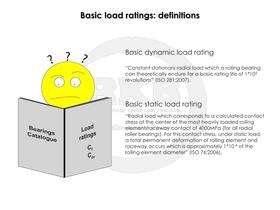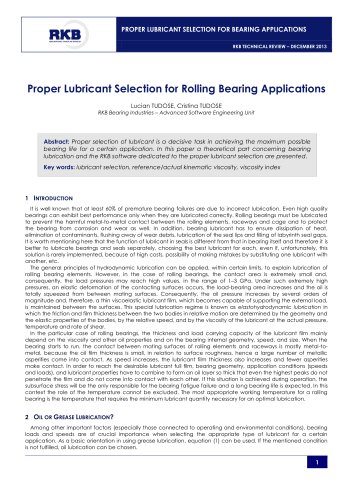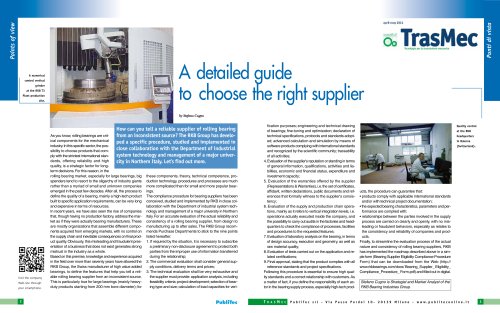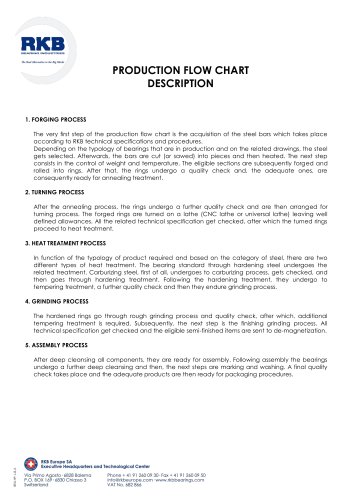
Catalog excerpts

Basic load ratings: definitions Basic dynamic load rating “Constant stationary radial load which a rolling bearing can theoretically endure for a basic rating life of 1*106 revolutions” (ISO 281:2007). Basic static load rating “Radial load which corresponds to a calculated contact stress at the center of the most heavily loaded rolling element/raceway contact of 4000MPa (for all radial roller bearings). For this contact stress, under static load, a total permanent deformation of rolling element and raceway occurs which is approximately 1*10-4 of the rolling element diameter” (ISO 76:2006).
Open the catalog to page 1
Basic load ratings: equations According to ISO 281:2007 and ISO 76:2006, the basic load ratings for radial rollers bearings are: Cr and C0r are function only of the bearing geometry 27 29 we 4 3 9 7 r m c we C ƒb *f *(i*L *cosƒÑ) * Z *D ƒÑ „Ê „Ê „Ë „É „º „º „» „¹ ƒÑ ƒ *D *cos D *cos we pw we we or * i * Z *L D C 44* 1-
Open the catalog to page 2
Parameters definitions bm = rating factor which varies with bearing type and design fc = factor which depends on the geometry of the bearing component i = number of rows of rolling elements Lwe = effective roller length (mm) á = nominal contact angle (degrees) Z = number of rolling elements per single row (with the same number of rolling elements per row in case of multi-row) Dwe = roller diameter applicable (mm) Dpw = pitch diameter of rolling elements (mm) For further information please refer to an RKB Main Technical Data Sheet (MTDS) report or watch the related educational video
Open the catalog to page 3
How to calculate the basic load ratings To calculate the basic load ratings it is necessary to know the bearing geometry, which can be obtained from: 1. The real bearing (set of parameters marked with “m”) 2. The 2D and 3D drawings of the bearing (set of parameters marked with “c”) 1. Measuring process of the bearing 2. 2D drawing of the bearing
Open the catalog to page 4
Example 1: SKF 313891 Parameters measurement The dimensions are evaluated from the 2D technical drawings (“c”) and the real bearing (”m”) 313891 2D drawing supplied by SKF 313891 2D drawing supplied by SKF Dwe measurement of SKF 313891 Lw measurement of SKF 313891 Lwe c Dwe c Dpw c ic Zc ác Lwe m Dwe m Dpw m im Zm ám Lwe = 24 mm Dwe = 18 mm Dpw = 190 mm i = 4 Z = 24 á = 0°
Open the catalog to page 5
Cr and C0r have been calculated for each set of parameters (“c”, ”m”) according to the ISO method (281:2007, 76:2006) Sets of parameters SKF catalogue (no. 6000EN) Mismatch % (between catalogue c m and calculated) Cr [kN] 770 770 897 +16,5 C0r [kN] 1650 1650 1660 +0,6 Example 1: SKF 313891 ISO basic load ratings calculation NOTE SKF displays a value of Cr larger than that of ISO while C0r remains the same „³ Cr is not computed according to the ISO 281 method
Open the catalog to page 6
Example 2: FAG NU226E Parameters measurement The dimensions are evaluated from the 2D technical drawings (“c”) NU226ET 2D drawing from FAG internet catalogue Lwe c = 26 mm Dwe c = 28 mm Dpw c = 181.5 mm ic = 1 Zc = 17 ác = 0° NU226E 2D model from FAG internet catalogue
Open the catalog to page 7
Set of parameters FAG internet catalogue Mismatch % (between catalogue and c calculated) C [kN] 367 425 +15,8 C0 [kN] 461 445 -3,4 Cr and C0r have been calculated according to the ISO method (281:2007, 76:2006) Example 2: FAG NU226E ISO basic load ratings calculation NOTE FAG displays a value of Cr larger than that of ISO while C0r remains practically the same„³ Cr is not computed according to the ISO 281 method
Open the catalog to page 8
Example 3: RKB NU 2322 EMAC3RS1 Parameters measurement The dimensions are evaluated from both 2D and 3D technical drawings (“c”) and the real bearing (”m”) RKB NU2322EMAC3RS1 2D drawing RKB NU2322EMAC3RS1 3D model d measurement of RKB NU2322EMAC3RS1 D measurement of RKB NU2322EMAC3RS1 Lwe c Dwe c Dpw c ic Zc ác Lwe m Dwe m Dpw m im Zm ám Lwe = 54 mm Dwe = 35 mm Dpw = 178 mm i = 1 Z = 13 á = 0°
Open the catalog to page 9
Example 3: RKB NU 2322 EMAC3RS1 - Technical Fiche
Open the catalog to page 10
Example 3: RKB NU 2322 EMAC3RS1 ISO basic load ratings calculation NOTE There is no mismatch between the results, because the load ratings of RKB bearings are computed according to the ISO methods Sets of parameters RKB Technical Fiche Mismatch % (between Technical c m Fiche and calculated) Cr [kN] 670 670 670 0 C0r [kN] 860 860 860 0 Cr and C0r have been calculated for each set of parameters (“c”, ”m”) according to the ISO method (281:2007, 76:2006)
Open the catalog to page 11
Example 4: RKB 313891 A2D Parameters measurement The dimensions are evaluated from both 2D and 3D technical drawings (“c”) and the real bearing (”m”) RKB 313891A2D 2D drawing RKB 313891A2D 3D model Lwe c Dwe c Dpw c ic Zc ác Lwe m Dwe m Dpw m im Zm ám Lwe = 25 mm Dwe = 18 mm Dpw = 192 mm i = 4 Z = 27 á = 0° Lw measurement D of RKB 313891A2D we measurement of RKB 313891A2D
Open the catalog to page 12
Example 4: RKB 313891 A2D - Technical Fiche
Open the catalog to page 13
Example 4: RKB 313891 A2D ISO basic load ratings calculation Sets of parameters RKB Technical Fiche Mismatch % (between Technical c m Fiche and calculated) Cr [kN] 870 870 870 0 C0r [kN] 1938 1938 1938 0 Cr and C0r have been calculated for each set of parameters (“c”, ”m”) according to the ISO method (281:2007, 76:2006) NOTE There is no mismatch between the results, because the load ratings of RKB bearings are computed according to the ISO methods
Open the catalog to page 14All RKB Europe catalogs and technical brochures
-
Company Business Card - T3
1 Pages
-
Cylindrical rolelr bearings
2 Pages
-
Technological bearings
2 Pages
-
Project S12
2 Pages
-
RKB Product Table
2 Pages
-
This Is RKB
24 Pages
-
RKB Phosphate Treatment
2 Pages
-
RKB General Information Form
12 Pages
-
Project "241 KPP VL"
2 Pages
-
Project "EPB"
2 Pages
-
Project "MDU"
2 Pages
-
Project "ABI"
2 Pages
-
TQOS Maintenance
3 Pages
-
AF2D Multiroll Cage Design
2 Pages
-
RKB_Europe_SA_ISO_9001
1 Pages
-
RKB_Europe_SA_ISO_14001
1 Pages
-
RKB_Europe_SA_OHSAS_18001
1 Pages
-
RKB_Europe_SA_ISO_27001
1 Pages
-
RKB_Europe_SA_ISO_10002
1 Pages
-
RKB_Europe_SA_ISO-TS_16949
1 Pages
-
RKB General Quality Program
50 Pages
-
RKB Special Projects
68 Pages
-
RKB Metals Industry Leaflet
2 Pages
-
RKB Company Snapshot
2 Pages
-
RKB Brief Company Profile
2 Pages
-
RKB_Taper_Roller_Bearings_Assy
39 Pages
-
RKB Bearings Production Range
34 Pages
-
RKB Bearings Catalogue
168 Pages
-
RKB Taper Roller Bearings Assy
39 Pages
-
Made in RKB
1 Pages
-
Why RKB
1 Pages
-
Bearing Industry Matrix
2 Pages
-
RKB Basic Information Form
1 Pages
-
RKB_Business_Card_T3
1 Pages
-
RKB_Business_Card_T2
1 Pages
-
RKB Message of the President
2 Pages
-
RKB Brief Introduction
2 Pages
-
RKB Digital Presentation
50 Pages
-
RKB PRODUCTION FLOW CHART
1 Pages
-
Company name and motto
6 Pages





































































































